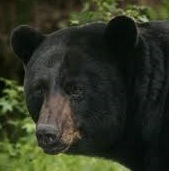The American black bear is a medium-sized bear native to North America.
It is the continent's smallest and most widely distributed bear species. Black bears are omnivores with their
diets varying greatly depending on season and location. They typically live in largely forested areas, but
do leave forests in search of food. Sometimes they become attracted to human communities because of the
immediate availability of food. The American black bear is the world's most common bear species.
It is listed by the International Union for Conservation of Nature (IUCN) as a "least concern" species, due
to its widespread distribution and a large global population estimated to be twice that of all other bear
species combined. Along with the brown bear, it is one of only two of the eight modern bear species not
considered globally threatened with extinction by the IUCN. American black bears often mark trees using their
teeth and claws as a form of communication with other bears, a behavior common to many species of bears.
Characteristics
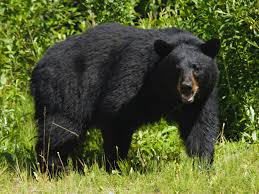
The skulls of American black bears are broad, with narrow muzzles and large jaw hinges. In Virginia, the
total length of adult bear skulls was found to average 262 to 317 mm (10.3 to 12.5 in). Across its range,
greatest skull length for the species has been reportedly measured from 23.5 to 35 cm (9.3 to 13.8 in).
Females tend to have more slender and pointed faces than males. Their claws are typically black or grayish
brown. The claws are short and rounded, being thick at the base and tapering to a point. Claws from both
hind and front legs are almost identical in length, though the foreclaws tend to be more sharply curved. The
paws of the species are relatively sizeable, with a rear foot length of 13.7 to 22.5 cm (5.4 to 8.9 in),
being proportionly larger than other medium-sized bear species but much smaller than the paws of large adult
brown and especially polar bears. The soles of the feet are black or brownish, and are naked, leathery and
deeply wrinkled. The hind legs are relatively longer than those of Asiatic black bears. The vestigal tail is
usually 4.8 inches (12 cm) long. The ears are small and rounded, and are set well back on the head.
Black bears are highly dexterous, being capable of opening screw-top jars and manipulating door latches.
They also have great physical strength. They have been known to turn over flat-shaped rocks weighing 310 to
325 pounds (141 to 147 kg) by flipping them over with a single foreleg. They move in a rhythmic, sure-footed
way and can run at speeds of 25-30 mph (40-50 km/h). Black bears have good eyesight, and have been proven
experimentally to be able to learn visual discrimination tasks based on color faster than chimpanzees and as
fast as dogs. They are also capable of rapidly learning to distinguish different shapes, such as small
triangles, circles and squares.
Behavior
A black bear has better eyesight and a better sense of hearing compared to humans. Their keenest sense is
the sense of smell, which is about seven times greater than a dog's. Black bears are excellent and strong
swimmers, doing so for pleasure and to feed (largely on fish). They climb trees regularly to feed, escape
enemies and to hibernate. Half of bear species are habitually arboreal (the most arboreal species, the
American and Asian black bears and the sun bear, being fairly closely related). Their arboreal abilities
tend to decline with age. Black bears may be active at any time of the day or night, although mainly forage
by night. Bears living near human habitations tend to be more extensively nocturnal and bears living near
brown bears tend to be more extensively diurnal.
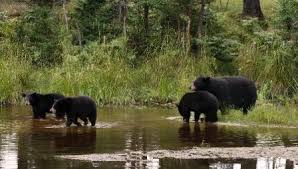
American black bears tend to be territorial and non-gregarious in nature. However, at abundant food sources
(i.e. spawning salmon or garbage dumps) black bears may congregate and dominance hierarchies form, with the
largest, most powerful males dominating the most fruitful feeding spots. They mark their territories by
rubbing their bodies against trees and clawing at the bark. Annual ranges held by mature male black bears
tend to be very large but there is some variation. On Long Island off the coast of Washington, ranges average
5 sq mi (13 km2), whereas on the Ungava Peninsula in Canada ranges can average up to 1,000 sq mi
(2,600 km2), with some male bears traveling as far as 4,349 sq mi (11,260 km2) in times of food shortages.
Black bears may communicate with various vocal and non-vocal sounds. Tongue-clicking and grunting are the
most common sounds and are made in cordial situations to conspecifics, offspring and occasionally humans.
During times of fear or nervousness, bears may moan, huff or blow air. Warning sounds include jaw-clicking
and lip-popping. In aggressive interactions, black bears produce deep-throated pulsing sounds. Cubs may
squeal, bawl or scream when in distress and make motor-like humming when comfortable or nursing.
Reproduction
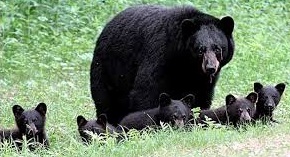
Sows usually produce their first litter at the age of 3-5 years. with those living in more developed areas
tending to get pregnant at younger ages. The breeding period usually occurs in the June-July period, though
it can extend to August in the species' northern range. The breeding period lasts for 2-3 months. Both sexes
are promiscuous. Males try to mate with several females but large, dominant ones may violently claim a
female if another mature male comes near. Sows tend to be short tempered with their mates after copulating.
The fertilized eggs undergo delayed development and do not implant in the female’s womb until November.
The gestation period lasts 235 days, and litters are usually born in late January to early February. Litter
size is between one and six cubs; typically two or three. At birth, cubs weigh 280-450 g (0.62-0.99 lb), and
measure 20.5 cm (8.1 in) in length. They are born with fine, gray, down-like hair, and their hind quarters
are underdeveloped. They typically open their eyes after 28-40 days, and begin walking after 5 weeks. Cubs
are dependent on their mother's milk for 30 weeks, and will reach independence at 16-18 months. At the age
of six weeks, they attain 900 g (2.0 lb), by 8 weeks they reach 2.5 kg (5.5 lb) and by the age of 6 months
they weigh 18 to 27 kg (40 to 60 lb). They reach sexual maturity at the age of three years, and attain their
full growth at 5 years.
Hibernation
Black bears were once not considered true or "deep" hibernators, but because of discoveries about the
metabolic changes that allow black bears to remain dormant for months without eating, drinking, urinating,
or defecating, most biologists have redefined mammalian hibernation as "specialized, seasonal reduction in
metabolism concurrent with scarce food and cold weather". Black bears are now considered highly efficient
hibernators. The physiology of American black bears in the wild is closely related to that of bears in
captivity. Understanding the physiology of bears in the wild is vital to the bear's success in captivity.
The bears enter their dens in October and November, although in the southernmost areas of their range
(i.e. Florida, Mexico, the Southeastern United States), only pregnant females and mothers with yearling
cubs will enter hibernation. Prior to that time, they can put on up to 14 kg (30 lb) of body fat to get them
through the several months during which they fast. Hibernation in black bears typically lasts 3-8 months,
depending on regional climate.
Hibernating bears spend their time in hollowed-out dens in tree cavities, under logs or rocks, in banks,
caves, or culverts, and in shallow depressions. Although naturally-made dens are occasionally used, most
dens are dug out by the bear itself. Females have been shown to be pickier in their choice of dens, in
comparison to males.
During their time in hibernation, bears' heart rate drops from 40-50 beats per minute to 8 beats per minute
and metabolic rate can drop to a quarter of a bear’s (non-hibernating) basal metabolic rate (BMR). These
reductions in metabolic rate and heart rate do not appear to decrease the bear's ability to heal injuries
during hibernation.
The hibernating American black bear does not display the same rate of muscle and bone atrophy relative to
other nonhibernatory animals that are subject to long periods of inactivity, due to ailment or old age.
A hibernating black bear loses approximately half the muscular strength to that of a well-nourished,
inactive human. The bear’s bone mass does not change in geometry or mineral composition during hibernation,
this implies that the bear’s conservation of bone mass during hibernation is due to a biological
mechanism. During hibernation bears retain all excretory waste, leading to the development of a hardened
mass of fecal material in the colon known as a fecal plug. A special hormone, leptin is released into the
black bear's systems, to suppress appetite.The retention of waste during hibernation (specifically in
minerals such as calcium) may play a role in the bear’s resistance to atrophy. The body temperature of the
American black bear does not drop significantly, like other mammalian hibernators (staying around 35 degrees
Celsius) and they remain somewhat alert and active. If the winter is mild enough, they may wake up and
forage for food. Females also give birth in February and nurture their cubs until the snow melts. During
winter, black bears consume 25-40% of their body weight. The footpads peel off while they sleep, making room
for new tissue.
Many of the physiological changes a bear exhibits during hibernation are retained slightly post-hibernation.
Upon exiting hibernation, bears retain a reduced heart rate and basal metabolic rate. The metabolic rate of
a hibernating bear will remain at a reduced level for up to 21 days after hibernation. After emerging from
their winter dens in spring, they wander their home ranges for two weeks so that their metabolism accustoms
itself to the activity. In mountainous areas, they seek southerly slopes at lower elevations for forage and
move to northerly and easterly slopes at higher elevations as summer progresses.
Diet
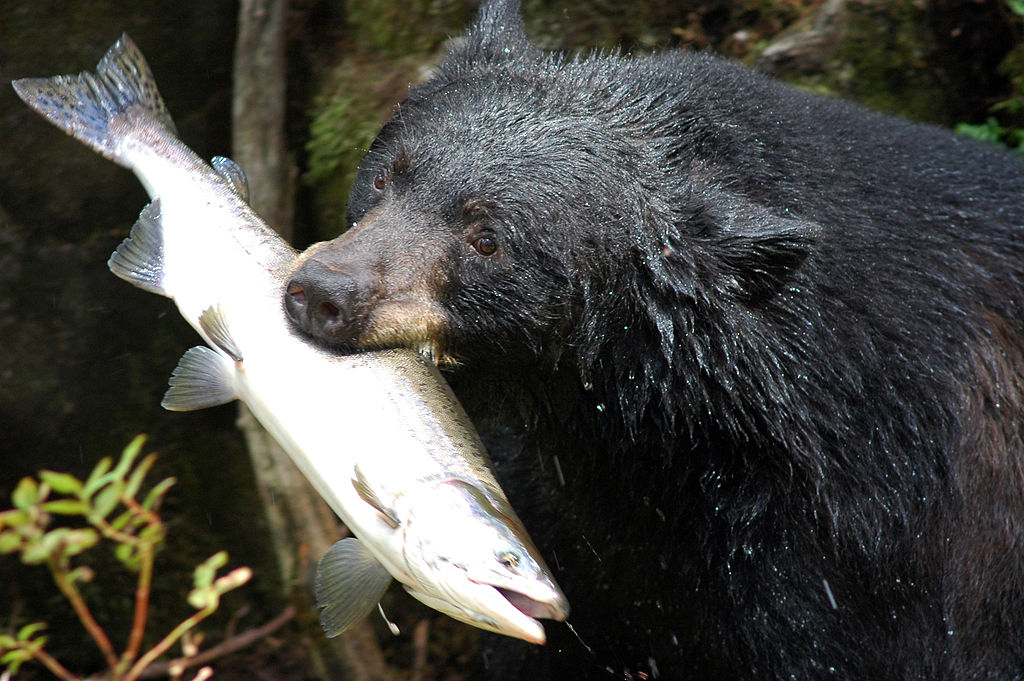
Generally, American black bears are largely crepuscular in foraging active, though may actively feed at any
time. Up to 85% of the black bear's diet consists of vegetation, though they tend to dig less than brown
bears, eating far fewer roots, bulbs, corms and tubers than the latter species. When initially emerging from
hibernation, they will seek to feed on carrion from winter-killed animals and newborn ungulates. As the
spring temperature warms, black bears seek new shoots of many plant species, especially new grasses, wetland
plants and forbs. Young shoots and buds from trees and shrubs during the spring period are also especially
important to black bears emerging from hibernation, as they assist in rebuilding muscle and strengthening
the skeleton and are often the only digestible foods available at that time. During summer, the diet is
comprised largely by fruits, especially berries and soft masts such as buds and drupes. During the autumn
hyperphagia, feeding becomes pretty much the full-time task of black bears. Hard masts become the most
important part of the black bear's diet in autumn and may even partially dictate the species distribution.
Favored masts such as hazelnuts, oak acorns and whitebark pine nuts may be consumed by the hundreds each
day by a single black bear during fall. During the fall period, American black bears may also habitually
raid the nut caches of tree squirrels. Also extremely important in fall are berries such as huckleberries
and buffalo berries. Black bears living in areas near human settlements or around a considerable influx of
recreational human activity often come to rely on foods inadvertently provided by humans, especially during
summertime. These include refuse, birdseed, agricultural products and honey from apiaries.
The majority of the black bear's animal diet consists of insects such as bees, yellow jackets, ants and their
larvae. Black bears are also fond of honey, and will gnaw through trees if hives are too deeply set into the
trunks for them to reach them with their paws. Once the hive is breached, black bears will scrape the
honeycombs together with their paws and eat them, regardless of stings from the bees. Black bears that live
in northern coastal regions (especially the Pacific coast) will fish for salmon during the night, as their
black fur is easily spotted by salmon in the daytime. However, the white furred black bears of the islands of
western Canada have a 30% greater success rate in catching salmon than their black furred counterparts.
Other fish including suckers, trout and catfish are readily caught when possible. Although black bears do not
often engage in active predation of other large animals for much of the year, the species will also regularly
prey on mule and white-tailed deer fawns in spring given the opportunity. In addition they have been recorded
similarly preying on elk calves in Idaho and moose calves in Alaska.
Black bear predation on adult deer is rare but has been recorded. They may even hunt prey up to the size of
adult female moose, which are considerably larger than themselves, by ambushing them. There is at least one
record of a male black bear killing two bull elk over the course of six days by chasing them into deep snow
banks where their movement is impeded. In Labrador, black bears are exceptionally carnivorous, living largely
off of caribou, usually sickly, young or dead specimens, and rodents such as voles. This is believed to be
due to a paucity of edible plant life in this sub-Arctic region and a local lack of competing large
carnivores (including other bear species). Like brown bears, black bears try to use surprise to ambush their
prey and target the sickly animals in herds. Once a deer fawn is captured, it is frequently torn apart alive
while feeding. If able to capture a mother deer in spring, the bear frequently begins feeding on the udder
of lactating females, but generally prefer meat from the viscera. Black bears often drag their prey to cover,
preferring to feed in seclusion. The skin of large prey is stripped back and turned inside out with the
skeleton usually left largely intact. Unlike wolves and coyotes, black bears rarely scatter the remains of
their kills. Vegetation around the carcass is usually matted down by black bears and their droppings are
frequently found nearby. Black bears may attempt to cover remains of larger carcasses, though they do not do
so with the same frequency as cougars and grizzly bears. They will readily consume eggs and nestlings of
various birds and can easily access many tree nests, even the huge nest of the bald eagle. Black bears have
been reported stealing deer and other animals from human hunters.



